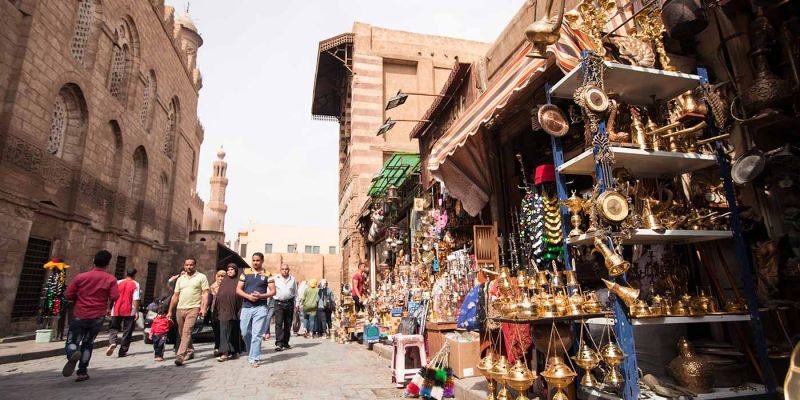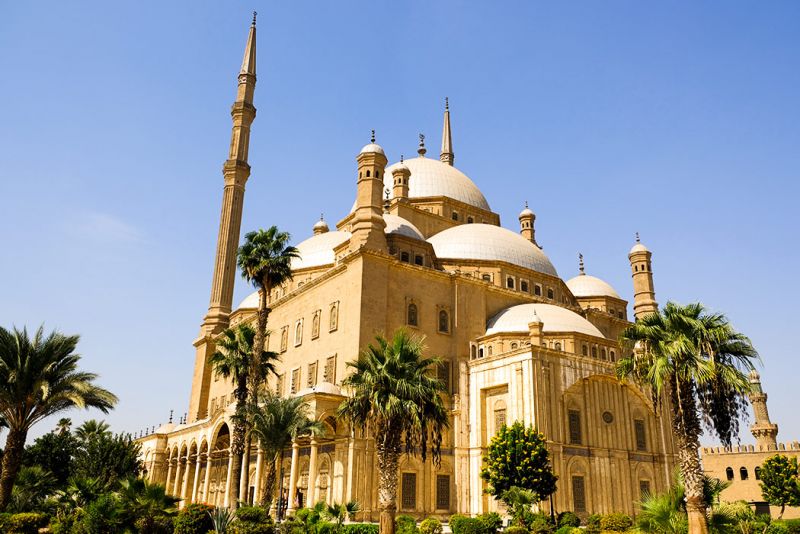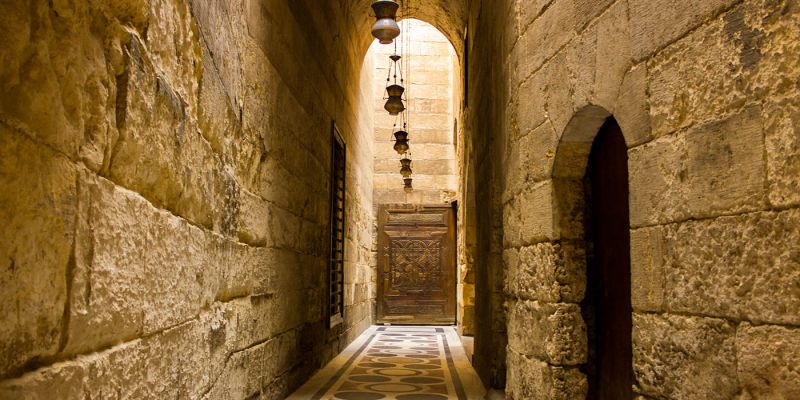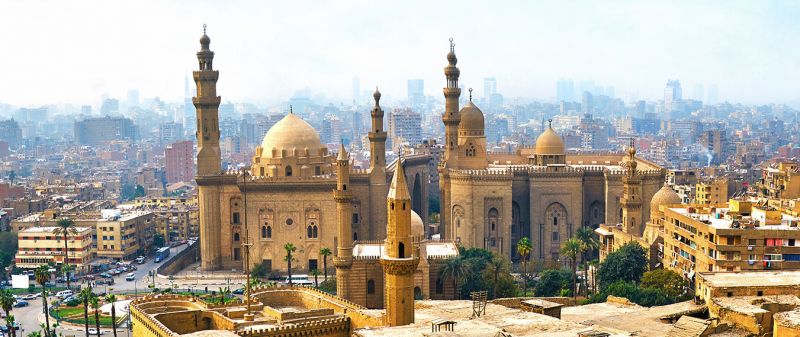Old Cairo was originally the seed of the modern city of Cairo now where the most remarkable sightseeing spots are located. First settlements started in Old Cairo 2000 years ago were the beginning of an ancient canal took place between the Nile River and the Red Sea. Although the water of the Nile has receded, Old Cairo is still the home location for astonishing historical sites now. Many of the sites date back to the Greco-Roman period with the Coptic Cairo sightseeings. Babylon fortress was constructed at this site that was considered the boundary between Upper Egypt and Lower Egypt at that time.
Here are some of the most remarkable spots to explore in Old Cairo:
Al-Muizz Al-Deen Allah Street
If you are looking for experiencing both the history of Islamic Cairo and the modern buildings alongside the ancient landmarks, then Al-Muizz street is the best place to visit. Some of the most famous landmarks not to miss while visiting Al-Muizz street are:

Al Aqmar Mosque
one of the most impressive and oldest landmarks in the area of Old Cairo. It has some interesting architectural features like its offset facade facing the street front. It stands out among other neighborhood buildings as they sit at an angle unlike the mosque. The mosque also aligns with the Muslim qibla, the direction where Muslims pray facing Mecca.
Sultan Al Mansur Qalawun Mosque
The mosque is built at the heart of Islamic Cairo. The complex includes a mosque, a medrasa, a mausoleum, and a maurista that was replaced by a modern hospital in 1920. The complex’ windows are inspired by the Gothic style of architecture that Sultan Qalawun was inspired by.

El Ghoreya
The Ghoreya complex is a famous landmark of the Al-Azhar area at the beginning of Al-Muizz street. On the east side of the street you will find the mausoleum that Al-Ghuri built. Sadly, his remains from the battle with the Ottomans were lost and not buried there.
Check out special Cairo tours and excursions tailored just for you.
Salah El-Din Citadel
Born in Tikrit, Iraq, in 1137 AD, Salah El-Din studied Quran, theology, astronomy, mathematics, and law. He was educated by his uncle as a member of the army, Asad-al-Din Shirkoh, who was the commander of the Zengid dynasty.
During military campaigns, Salah El-Din was able to take on leading duties, and that's because of his extraordinary success during wars. He was also able to move on from being a soldier to being the King of both Egypt and Syria through his great abilities and cleverly executed tactics. His power allowed him to overthrow the Fatimids in Egypt and retain authority.
The centerpiece of these great fortifications was the Citadel, which defended the city from the heights of the rocky hills that overlooked it. Saladin's Citadel, completed in 1183 AD, served as the seat of government in Egypt for 700 years until in the 1870s, Khedive Ismail moved into Abdeen Palace.
The Citadel was expanded by many rulers after it was originally a fortress against the crusaders. The Citadel also was the centerpiece that used to protect the city from the heights of hills that overlooked it. The Citadel also was the seat of Egypt government for 700 years. The place for government changed when Khedive Ismail moved to Abdeen palace in downtown cairo in 1870.

Mohamed Ali Mosque
The father of modern Egypt is considered to be Mohammad Ali.In 1805, he established the Khedivate of Egypt and Sudan. Then came the french occupation between 1798 and 1801, that’s when his descendants ruled Egypt until the 1952 revolution by the free officers.
Mohamed Ali built one of Cairo’s most astonishing landmarks that still stands today. He built the Alabaster mosque in memory of his son after he passed away. The mosque can be clearly seen from over the rest of the complex. In addition to Mohamed Ali mosque, the Citadel also includes the National military Museum which contains the clothes and weapons of soldiers at that time, a police museum, and other several museums that belong to Mujhamed Ali’s palace.
Book your tour to Citadel and Old Cairo Now!

Amr Ibn Al Aas Mosque
Amr Ibn Al-Aas was one of the most important figures of the Egyptian history as he was the one to introduce Islam to Egypt. He founded the city of Fustat, located north of the Babylon fort. Amr Ibn Al-Aas mosque is still a remarkable building in the site of Fustat city. None of the mosque’s original structure remains today as the mosque was renovated many times. But still, Amr Ibn Al-Aas mosque is the oldest in Egypt and Africa.
Some interesting facts about Amr Ibn Al-Aas Mosque are, legend said that while the army was camping outside the city, a dove nested on top of the general’s tent. While the army was preparing to move to Alexandria, Egypt’s capital during the Greco Roman period. After the Muslim army took over Alexandria to take control of all Egypt, Caliph Umar wanted to establish a new capital closer to Medina.
Amr Ibn Al-Aas ordered that his tent be left where it stands because he took the dove’s nest as an omen of God’s will. Later, Amr Ibn Al-Aas ordered that a mosque be built at the site where the tent stands and the mosque became the centre for Egypt’s new Muslim capital, Fustat. The mosque was founded in 642 AD and was named after the general Amr Ibn Al-Aas, and became the first mosque to be built in Egypt and entire Africa.
Check this Islamic Cairo Tour and enjoy the Islamic history of Egypt!
Sultan Hassan Mosque & Madrasa
The mosque is an incredible example of Mamluk architecture, it was constructed in the 14th century. The massive size of the mosque was impressive back then and still leaves a great impression to visitors nowadays because of its architecture and beauty.
Sultan Hassan, whom the mosque was called after him in Old Cairo assigned the supervision of building the mosque to prince Muhammad Ibn Babylik Al-Muhassani. The mosque was built of stones and bricks and took 4 years to be completed. The site where the mosque was built was known as souk al Khayl or the market of horses.
The mosque is considered one of the islamic world’s most iconic monuments. Sultan Hassan mosque is the landmark of Islamic ancient Egypt as much as the Giza pyramids to ancient pharaonic Egypt. The interior part of the mosque is beautifully decorated and has a huge significant central court. The mosque is not only famous for its huge size, but also considered as the most iconic among other monumental mosques in Cairo.

The Coptic Museum in Cairo
Coptic Cairo is an outstanding area within the area of Old Cairo that you shouldn’t miss to visit. The area of Coptic Cairo has several Christian churches and other beautiful sites that date back to the period between the decline of the pharaonic religion and the Islamic Period. Coptic Cairo was mainly built around the Babylon fort on the remains of its walls.

The Coptic museum houses a unique collection of artifacts and artwork dating back to the history of Coptic Egypt and is considered the largest collection of Coptic Christian artifacts in the world . The museum is considered as an exhibition for the history of Christanity in Egypt.
Under the Romans, Coptic Christianity was the dominant religion in Egypt before Islam arrives in the 7th century. It was founded in 1910 and houses the records of Coptic history starting from the arrival of Christianity in Egypt and then the Ottoman era. Also, the museum displays several artwork inspired by the Egyptian, Ottoman, Byzantine, Roman, and Greek traditions.
Check out our special 4 Day: Cairo Short Break and enjoy both Islamic and Coptic Cairo.
